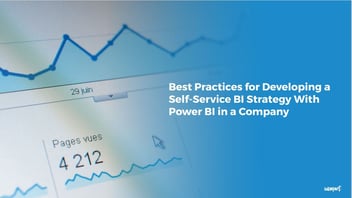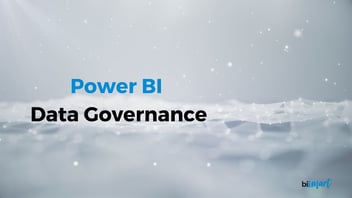Tools that facilitate and automate the application of data governance measures have become key technologies for business decision making.
Companies' technological transformation has led to the need for data governance strategies. Data governance tools and their correct use are vital for proper information management and strategic decision making.

As the amount of information and data that a company stores multiplies, its management becomes more complicated and data governance policies and measures become more important.
Data governance is now a fundamental requirement for any corporation. The correct management of data assets influences their quality. In this sense, to guarantee data quality we need data governance policies.
What is data governance?
The concept of data governance refers to the ability of companies to properly manage the information and data they possess. It therefore involves data analysis and its control.
The ultimate goal of a data governance strategy is to turn data into useful information. This data must be used to make data driven decisions, decisions that are taken after processing the data, analyzing it and transforming it into information and insights through reporting and data visualization.
Why is it important?
Not having a proper data governance strategy is, above all, a disadvantage against your competition. Today, implementing a good data control plan is vital to reduce costs, increase profits, and properly exploit all the information you have through data-driven decisions.
Start with a solid Data Governance in Power BI
Download the complete guide to understand how to implement an effective governance framework in Power BI from day one.
Advantages of data governance for a company
The lack of SQL knowledge or the inability to carry out a correct data analysis can make the information unusable. This is where data governance comes in, providing a number of advantages with respect to the processing of these resources
- Increases data quality by transforming data into high-value information that can be used by the different departments of the company.
- Helps in implementing an efficient data management strategy through data curation.
- Increases employee's productivity, allocating resources appropriately to those tasks where they are most needed.
- It allows interconnecting information and making decisions based on data science and big data. This type of decision making is safer and involves less risk.
- It offers the possibility of knowing all the information related to the useful life of the data: who produced it, where it came from, what it was used for, and when it was discarded.
- It reduces uncertainty and risk through reporting or obtaining information, two particularly important factors in certain economic sectors. It therefore increases the reliability of assets.
How to implement data governance policies in your company?
There is no single method when it comes to implementing measures for the correct management of information and data analysis, although there are a series of more generic steps that can be taken into account when incorporating data governance tools:
- Preliminary analysis: to find out the degree of digital transformation your company is in, as well as the data it already has.
- Internal identification: it is important to know who the employees in charge of handling the data are, what knowledge they have about data analysis, and how the information is managed.
- Implementation of data governance tools: they must be in line with the purpose for which you are going to process the data, and with the tools, software or solutions available.
Start with a solid Data Governance in Power BI
Download the complete guide to understand how to implement an effective governance framework in Power BI from day one.
5 useful data governance tools for companies
As companies get used to working with data, developing a data-driven culture and leveraging the value of data analytics, data governance tools gain relevance.
1. Azure Pureview
It is one of Microsoft's essential data governance tools. With Azure Pureview you can carry out fully automated data discovery and analysis processes, as well as classify data by category. In addition, it includes external data access functionalities, and systems specially designed to control the useful life of the information (data lineage).
With Purview, users can discover and document data in their systems, automate data classification according to predefined policies, and establish access and compliance controls to protect sensitive data. It also integrates with other Microsoft tools, such as Azure Data Factory and Power BI, to provide a consistent user experience for managing data across the organization.
2. Talend
Talend is a data integration platform that provides a variety of tools to assist in data governance, including data cleansing, data transformation and data quality. It also enables the creation of rules and policies to manage data, as well as reporting for data tracking and auditing. In addition, it offers data security features to comply with data privacy standards.
In short, Talend helps organizations to efficiently manage and protect their data and comply with data governance requirements.
3. Cloudera Enterprise
Cloudera Enterprise is a Big Data and data analytics platform that integrates multiple data governance processes. Among the functions it offers for data governance management we have:
- Cloudera Navigator: it is a data governance tool that enables organizations to discover, understand and track the use of their data over time.
- Cloudera DataLineage: it is a tool that enables organizations to track and understand how data moves, transforms and is used throughout their systems and applications.
- Cloudera Data Governance Suite: it is a suite of data governance tools that includes Cloudera Navigator and Cloudera DataLineage, as well as additional features for metadata management, data quality and data security.
In addition, Cloudera Enterprise offers security features to protect data and comply with data privacy standards. It is also scalable and integrates with other tools and technologies such as Hadoop, Apache Spark, Apache Kafka, etc.
All in all, Cloudera Enterprise is a complete data management solution that helps organizations maintain control and visibility of their data, comply with data governance requirements and gain valuable insights from it.
4. Xplenty
Xplenty offers a variety of data governance solutions to help companies manage and monitor their data. These solutions include data management, data auditing, data monitoring, data governance, data security and data integration tools.
These tools enable enterprises to identify, understand and control data to improve data quality, meet regulatory compliance requirements and ensure data integrity.
In addition, Xplenty also offers the ability to manage and monitor data in real time, to enable companies to respond to changes in data quickly.
5. Governance for Power BI: The Ultimate Solution for Data Governance in Power BI
Bismart has developed Governance for Power BI, a comprehensive governance solution for Power BI that automates the documentation of datasets and dataflows, enriches them with functional and business information, and enables centralized tracking of all activity in the Power BI environment, both at the user and reporting levels.
Other Data governance tools for Power BI
As of today, Power BI is Microsoft's flagship business intelligence platform; it is also the leading BI and analytics platform in the market according to the latest Gartner Magic Quadrant. Through this solution, Microsoft provides its users with comprehensive access to the company's internal and external data. In addition, it generates global visual reports that are used to implement business strategies and make strategic decisions.
Despite the functionalities offered by Microsoft Power BI, it is possible to get better data governance features with optimization software:
- Power BI Viewer: This solution allows you to visualize all the reports generated in Microsoft Power BI in a single platform through a Power BI Embedded license. You can also share them with users outside the organization even if they don't have a Power BI license. In addition, Power BI Viewer has the ability to increase security in the transmission of information, thanks to its access management and permissions per user, per report, category or per workspace system.
- Power BI Analytics: With Power BI Analytics you can view the history of the activity, exceeding the one-month limit offered by Microsoft's default program. In addition, the information obtained from the history can be compared with license information. With this, you can optimize the use of Power BI in your company, make better use of your resources and, ultimately, save money.
- Power BI Data Catalog: This data governance solution is especially useful if you have a lot of data assets and reports or if your employees are not sufficiently trained or are not used to working with data. Power BI Data Catalog allows you to complement the datasets with functional and business descriptions, in addition to many other features to ensure the correct use of the information available.
Conclusion
Companies need data governance policies to ensure that data is secure, managed responsibly and used efficiently. They also establish a framework for regulating the use of data, which reduces the risk of data breaches and protects users' privacy.
The data governance tools mentioned in this article can help organizations streamline and automate the management of their data efficiently and securely. This includes metadata management, data access management, data auditing, data quality management and compliance management. These tools can also help improve decision making by providing information about how data is used and how it has been collected.
Start with a solid Data Governance in Power BI
Download the complete guide to understand how to implement an effective governance framework in Power BI from day one.





